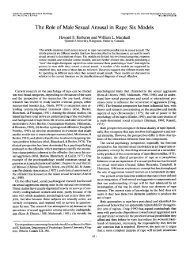Regulation of the dopamine transporter - Addiction Research ...
Regulation of the dopamine transporter - Addiction Research ...
Regulation of the dopamine transporter - Addiction Research ...
Create successful ePaper yourself
Turn your PDF publications into a flip-book with our unique Google optimized e-Paper software.
Schmitt & Reith DAT <strong>Regulation</strong><br />
diaryle<strong>the</strong>ne moiety (with excitation and emission<br />
spectra <strong>of</strong> 488 nm and 609 nm, respectively 99 ).<br />
Hence, unlike o<strong>the</strong>r potential surrogate DAT substrates<br />
(e.g., [ 3 H]MPP + and [ 3 H]amphetamine), it<br />
is possible to measure <strong>the</strong> cellular uptake and accumulation<br />
<strong>of</strong> ASP + in real time by using fluorescent<br />
microscopy. In EM4 cells coexpressing hDAT and<br />
D2R transcripts, receptor activation with quinpirole<br />
increases <strong>the</strong> rate <strong>of</strong> ASP + uptake compared<br />
with vehicle treatment—this effect was abolished<br />
in cells treated with PTX, corroborating <strong>the</strong> necessity<br />
<strong>of</strong> Gi/Go protein–coupled signaling for functional<br />
DAT upregulation. 100 Moreover, inhibition <strong>of</strong><br />
MEK (which, in turn, prevents ERK1/2 activation)<br />
blocked <strong>the</strong> effects <strong>of</strong> quinpirole, whereas PI3K inhibition<br />
had no effect. Treatment with quinpirole<br />
also increases surface expressed DAT (with a concomitant<br />
decrease in intracellular-localized DAT),<br />
as measured by biotinylation. Similarly, quinpirole<br />
also increases plasmalemmal DAT expression and<br />
ASP + uptake in EM4 cells coexpressing hDAT and<br />
D3 receptors. 101 Like <strong>the</strong> DAT upregulation mediated<br />
by D2 receptor activation, this effect is PTX<br />
sensitive; however, both <strong>the</strong> MAPK and PI3K pathways<br />
are required for <strong>the</strong> quinpirole-induced increase<br />
in DAT function. Interestingly, much like <strong>the</strong><br />
observations <strong>of</strong> Johnson et al. 31 for amphetaminergic<br />
substrates, D3 activation results in a rapid increase<br />
in surface DAT expression that eventually<br />
gives way to significantly reduced plasmalemmal<br />
<strong>transporter</strong> expression upon prolonged D3 agonist<br />
exposure. 101 As a tritiated alternative to fluorescent<br />
ASP + , it also appears possible to use tracer amounts<br />
<strong>of</strong> [ 3 H]tyramine for monitoring DAT function in<br />
experiments disentangling <strong>transporter</strong> and receptor<br />
phenomena, because tyramine has been shown to<br />
display ra<strong>the</strong>r low potency (micromolar) in activating<br />
D2 <strong>dopamine</strong> receptors. 100 It will be important<br />
to show that <strong>the</strong> tritiated ligand does not appreciably<br />
bind to <strong>dopamine</strong> receptors; caution is required<br />
because <strong>the</strong> thorough study <strong>of</strong> Zapata et al. 101<br />
shows considerable binding <strong>of</strong> [ 3 H]<strong>dopamine</strong> to D3<br />
<strong>dopamine</strong> receptors that can be displaced by 0.1 �M<br />
spiroperidol in cells that do not express hDAT compared<br />
with cells subjected to <strong>the</strong> same conditions<br />
with hDAT on board.<br />
One unexpected finding in this series <strong>of</strong> receptormediated<br />
ASP + -uptake experiments was <strong>the</strong><br />
observation <strong>of</strong> positive resonance energy transfer<br />
between fluorescent-tagged hDAT and a biolumi-<br />
nescent D2R–luciferase construct, suggesting that<br />
<strong>the</strong> DAT and D2R proteins are in proximity (










